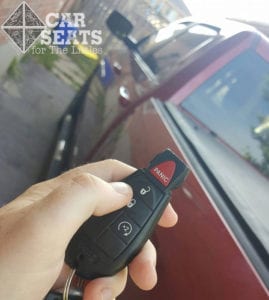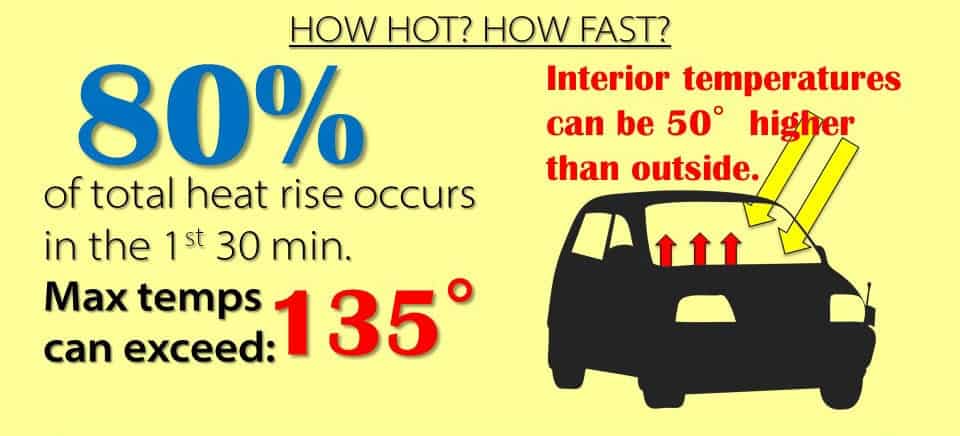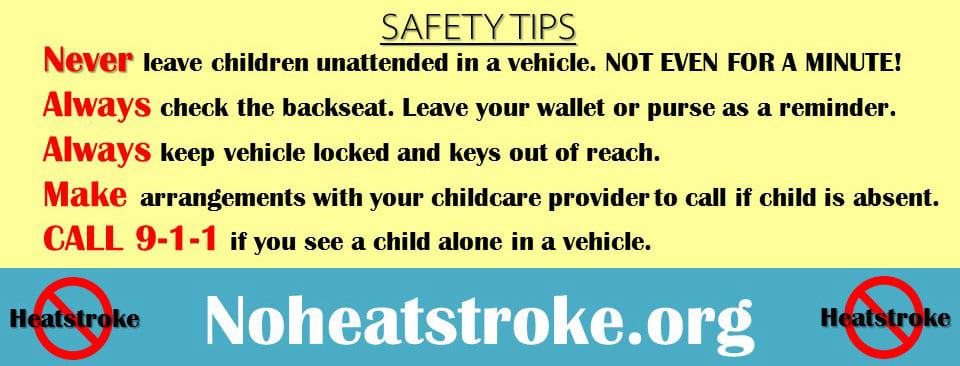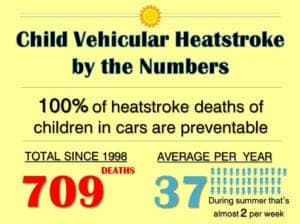In 2016, I had the privilege of meeting with Research Meteorologist in the San Jose State University Department of Meteorology and Climate Science Jan Null, founder of http://noheatstroke.org/. Jan’s work with vehicular heatstroke began in 2001 when a local news station called him for a comment on the tragic death of a 5 month old boy who was left in the car. Always the scientist, Jan looked for peer-reviewed studies but found none. To fill this critical gap in the research, he worked with doctors and residents from Stanford to complete a study on hot temperatures in cars. This study began what’s become his passion — spreading awareness of this critical issue.
Since that fateful day, Jan’s been collecting data. His data has become the de facto standard for the child passenger safety community. The work he’s done is summed up in one heartbreaking infographic.
We’ll break down our conversation with Jan by using each section of the infographic as our guide.
Child Vehicular Heatstroke by the numbers. 100% of heatstroke deaths of children in cars are preventable.
First, let’s define a few terms:
Hyperthermia refers to a broad range of heat illness.
Heatstroke is very specific — the body temperature is over 104 degrees.
When a first responder gets a heatstroke call, they’re looking for the following: the child is flushed and dry, hot to the touch. When heatstroke occurs, the body stops perspiring.
Children’s body temperatures rise 3-5 times faster than that of adults. The way car seats surround the child prevent perspiration around the child’s back, thighs, and shoulders.
When a child’s body temperature reaches 107 degrees, their organs begin to shut down. There’s a cascade effect of injuries and organ failures that eventually causes death. Children who are rescued from an overheated vehicle often live with significant brain damage.
Total fatalities since 1998: 716 deaths (updated since infographic was produced).
A Word About Pets
Vehicular heatstroke risk is equally risky for pets as it is for humans. Please don’t leave your pets in a parked car.
Average per year: 37 deaths. During the summer, that’s almost 2 children per week. 2 preventable deaths per week.
In these cases, there’s no clinical test to determine cause of death. Environmental heatstroke is an exclusionary ruling, meaning that it has to be the sole cause of death in order to be classified that way. This means that vehicular heatstroke may contribute to additional deaths but unless they’re classified as environmental heatstroke, they won’t appear in Jan’s data.
Circumstances
54% of these deaths are children who are accidentally forgotten. Almost half of these children were not dropped at daycare.
17% of these deaths are children who are intentionally left in the vehicle. It only takes 15-20 minutes for the vehicle interior to reach a lethal temperature. On a 70 degree day, the interior temperature can reach a lethal 130 degrees. Florida has a law that allows a child to be left in the vehicle for 15 minutes — just long enough for the child to die.
Leaving the vehicle window open a crack only reduces the car’s interior temperature by 2-3 degrees. An open window is thus not enough to cool down the vehicle to a safe temperature.
29% of these deaths are children who gain access to a parked, unlocked vehicle.
1% of these deaths are children who die from unknown heat-related causes.
There tends to be more focus on the accidentally forgotten children. That’s the biggest percentage. The intentionally left children are grouped into the 54%
There’s a proportionate number of kids gaining entry into an unattended vehicle.
There needs to be messaging around not letting kids play in cars. Keep vehicles locked. Keep keys and remote locking keyfobs away from children. Teach older children how to unlock the vehicle from the inside.
Breaking It Down/What You Can Do
To prevent the most common cause of vehicular heatstroke, Look Before You Lock.

Look before you lock
We’ve been sharing different ways to add this reminder to your daily routine. Some suggestions include talking to yourself, repeating “Look before you lock” as you get out of the car and leaving an important item such as a shoe or cell phone where you will check the back seat before you leave the vehicle.
To prevent the second most common cause of vehicular heatstroke, Lock Before You Leave.

Lock before you leave
During the summer months, families tend to be in and out of the home more often. That can lead to curious children heading to the car to look for a forgotten toy and accidentally becoming trapped. Lock your vehicle before heading inside.
When a child is missing, check the pool, and then check any cars and the trunk. Pools and cars are where the danger is the fastest. There have been cases where people walked by for hours and the child was on the floorboard. If they’re hiding in a shed or under a bed or in the closet, they’re in trouble but they’re not dead.
Ages of Children/Forgetting can Happen to Anyone
Of the 716 children who have died from vehicular heatstroke since 1998, 340 of them were less than 2 years old. It’s this group who needs the most help.
Every time we post a heatstroke-themed article or infographic on our CSFTL Facebook page and to our Facebook group leave hateful comments every time we share something related to vehicular heatstroke. The Forgetting Can Happen To Anyone section of Jan’s infographic is the key takeaway in all of this:
IT CAN HAPPEN TO ANYONE.
It does happen to anyone. Our mission and Jan Null’s mission is to help caregivers find ways to prevent this avoidable tragedy.
Here’s how we’d like to increase awareness and remove the shame from this topic.
- By educating the public.
- Sharing information about how this can happen to anybody. That these deaths, by some measures, can be called an epidemic. If you look at the number of deaths we had from Ebola last year? 0. Look at all the media attention.
There are lots of epidemic/pandemics that make headlines. Their numbers are pretty small. They have the potential for huge numbers so they get large headlines. Those events happen in a cluster. These events happen all over.
When a death occurs, local media will call Jan for a quote because they’ve never had a hot car death happen in their area. These deaths are scattered so the awareness around this issue grows at a different rate than more localized crises like floods or quickly-spreading diseases.
It can happen to anyone. Any socio-economic group. Anybody can forget.
U.S. Child Vehicular Heat Deaths
This is the most heartbreaking portion of the infographic. It shows the number of deaths for each year since 1998. The average is 37.
How Hot? How Fast?

How hot? How fast?
80% of the heat rises in the first 30 minutes. Maximum temperatures can exceed 135 degrees. Interior temperatures can be 50 degrees higher than the outside temperature. Air temperature is outside in direct sunlight.
If a child is left in direct sunlight, it could be a matter of minutes before the situation becomes dire.
Children should not be left in unattended vehicles even for a minute. Lots of other things can happen to kids unattended in cars besides dying from heatstroke.
Some examples:
- Cars are stolen with the child inside.
- Children put the cars in gear, injuring themselves or others.
- 50% of the cars on the road are more than 7 years old. These cars lack the latest safety features, including updated power windows. Children left unattended in these older vehicles are at risk for power window strangulations and other injuries.
As Child Passenger Safety Technicians, we regularly meet up with caregivers for private seat checks or work seat check events. Jan suggests that a handout would help and mentioned some progress in this area: Texas now has a neat law where when new babies are discharged from the hospital, they’re given a heatstroke prevention handout.
Make it a talking point of the event. Did you know that your car’s interior air temperature can reach 130 degrees on a 70 degree day?
Safety Tips

Heatstroke safety tips
Here are some easy things that caregivers can do to prevent these tragedies:
- Look before you lock. Check the vehicle’s back seat before locking the doors.
- Lock before you leave. Lock the vehicle before walking away.
- Keep kids away from the keys.
- Put your purse, briefcase, lunch, in the back seat.
- Put your cell phone in the back seat.
Increased Awareness
Over the last couple of years, we’ve seen increased awareness campaigns from NHTSA and SafeKids. We’re hopeful that this additional education will help lower and eliminate the number of vehicular heatstroke deaths.
100% of these deaths are preventable. Please share this article far and wide. Visit http://noheatstroke.org to learn more about this heartbreaking topic and share information about any fatalities not listed there already.
Finally, let’s remember Jan’s one tidbit of information for every caregiver?
It can happen to anyone.
Learn more in our other articles:
- Hyperthermia (Article)
- Vehicular Heatstroke Prevention (Guide)





